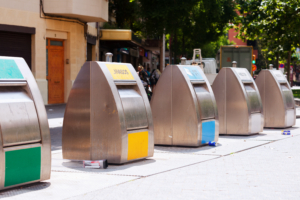Introduction
In the search for smarter and more tolerable cities, waste management has evolved a major focus for administrations and environmental corps. One innovative solution earning momentum is the opening of bins fitted with IoT sensors. These smart systems offer real-time data display, optimize supply routes, reduce operating costs, and donate significantly to environmental protection.
What Are Smart Bins?
bins are technologically improved waste receptacles integrated with Internet of Things (IoT) sensors. These detectors collect data on waste levels, temperature, and place. The gathered data is transmitted to a central venue that helps waste control teams monitor and collect bin accommodations in real-time. This stops the need for regular manual checks, enhancing efficiency and reducing costs.
How Shrewd Bins Work
The functionality of smart bins relies heavily on IoT technology. Here’s a step-by-step investigation of how they work:
- Sensor Installation: IoT sensors are implanted inside the bin to see fill levels, temperature, and movement.
- Data Transmission: Utilizing wireless technologies like Wi-Fi, GSM, or LPWAN, the detector data is sent to a shadow platform.
- Data Analysis: The forum uses data analytics tools to predict when the bin will get capacity, providing timely waste grouping.
- Automated Alerts: Once a bin approaches full capacity, the design automatically notifies rubbish collection teams.
- Route Optimization: Using AI algorithms, the method generates the most efficient supply routes, keeping time and fuel costs.
Key Advantages of Smart Bins
The adoption of smart bins offers multiple advantages for municipalities, enterprises, and citizens:
1. Optimized Waste Collection Routes
By understanding which bins are full, waste supply teams can plan the most efficient routes, decreasing travel time and fuel consumption. This outcome in lower operating costs and more irregular carbon emissions.
2. Reduced Overflow and Littering
Overfilling bins are common in densely settled areas. Smart bins provide real-time data, providing they are opened before reaching power, enhancing hygiene and general aesthetics.
3. Cost Savings
By decreasing the number of extreme waste group trips, cities can allocate help more actually. With predictive analytics, collection programs can be purified for enhanced efficiency.
4. Environmental Benefits
With optimized routes and more occasional trips, carbon prints are reduced. Also, timely waste disposal prevents toxic waste leakage into the atmosphere.
5. Data-Driven Insights
Smart bins contain valuable data on waste patterns, allowing authorities to design targeted methods for recycling programs, understand campaigns, and enhance waste removal policies.

Applications of Smart Bins
The versatility of smart bins makes them suitable for different industries and environments:
- Urban Areas: Cities leverage smart bins to handle high-importance rubbish efficiently.
- Public Transport Stations: Airports, train stations, and bus stops use smart bins to stop waste overflow.
- Commercial Establishments: Companies adopt smart bins to provide clean premises and enhance customer satisfaction.
- Educational Institutions: Schools and colleges use smart bins to promote sustainability among students.
- Healthcare Facilities: Medical waste management is improved with smart bins, providing timely and secure disposal.
Challenges in Implementing Smart Bins
Despite the multiple benefits, the deployment of bins arrives with some challenges:
- High Initial Costs: The structure of IoT detectors and data platforms requires noteworthy investment.
- Maintenance Needs: Detectors may need periodic calibration and supervision for accurate readings.
- Connectivity Issues: Small locations may face connectivity challenges that slow data communication.
- Data Security Concerns: As IoT methods rely on data business, providing cybersecurity is important to prevent hacking or data violations.
Case Studies of Flourishing Smart Bin Implementation
1. Barcelona, Spain
Barcelona has incorporated thousands of bins throughout the city. By utilizing real-time data, the city diminished waste supply costs by 20% and enhanced public cleanliness.
2. Singapore’s Smart Nation Initiative
Singapore presented bins across its parks and public spaces. These bins alert care teams before earning capacity, providing seamless waste removal services.
3. New York City, USA
New York embraced smart bins in high-traffic zones. The design optimized collection routes, decreasing waste supply truck traffic and underestimating environmental effects.
The Future of Smart Bins
As cities develop and environmental problems intensify, bins are set to play a key role in sustainable urban growth. Advancements in AI, machine learning, and data analytics will further improve their capabilities, making manure management plans more thoughtful and responsive.
Future inventions may include:
- Solar-Powered Smart Bins: Self-sufficient bins powered by solar boards to ensure continued operation.
- Self-Compressing Bins: Bins that automatically close waste, developing their capacity.
- AI-Enhanced Analytics: Predictive measures that enhance waste collection forecasting and enable active route adjustments.
Deduction
The integration of bins with IoT sensors is changing waste management procedures worldwide. By improving efficiency, reducing costs, and enhancing environmental sustainability, bins are a vital solution for contemporary cities. Investing in these technologies not only streamlines waste control but also enables cleaner, greener urban environments.
As cities and businesses continue to embrace bins, their potential to revolutionize waste management will only grow. Adopting this technology is a step ahead in achieving savvier, more tolerable cities for future ages.







